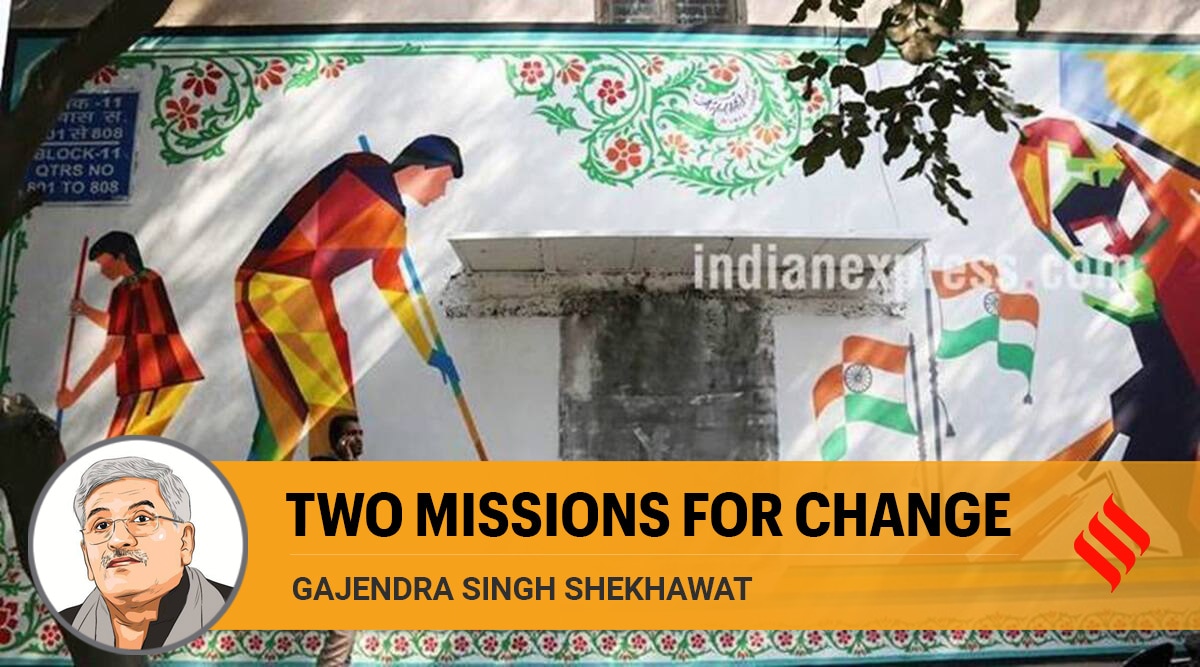 The government has launched Swachh Bharat Mission Phase 2 with a focus on plastic waste management, biodegradable solid waste management, grey water management and faecal sludge management.
The government has launched Swachh Bharat Mission Phase 2 with a focus on plastic waste management, biodegradable solid waste management, grey water management and faecal sludge management.Many have likely heard the parable about a bundle of sticks. Its premise is that one stick may break but when many sticks are bundled together, it’s impossible to break the stack. This story taught us the power of unity. Another word for unity is convergence — when ideas, projects and schemes merge, miracles happen. Prime Minister Narendra Modi is a flagbearer of this idea.
The late Arun Jaitley introduced convergence as one of the primary operating principles of the government in his first budget speech. At the Jal Shakti Ministry, we have tried to put this concept to the test. The best exhibition of this can be found in the ways in which the Jal Jeevan Mission and Swachh Bharat Mission work in tandem, one enabling the other.
During the first term of this government, the Swachh Bharat Mission was launched to stop the scourge of open defecation. More than 10 crore toilets, a record, were built, but this accomplishment could have been difficult had the government not had the foresight to build the toilets on a twin-pit design that has in-situ treatment of faecal sludge. Now, providing tap water connections through the Jal Jeevan Mission is among the government’s top priorities. Over 9.6 crore rural households get tap water supply; notably, more than 6.36 crore households have been provided tap water connections since PM Modi announced the programme in August 2019.
The Jal Jeevan Mission faces a challenge similar to that faced by the Swachh Bharat Mission — managing grey water discharge. About 70 per cent of all household water turns into grey water, which if untreated leads to undesirable consequences. This is where the concept of convergence comes in.
Best of Express Premium
The government has launched Swachh Bharat Mission Phase 2 with a focus on plastic waste management, biodegradable solid waste management, grey water management and faecal sludge management. It has been as nimble and innovative in its thinking as when twin-pit toilets were used in the Mission’s first phase. When household tap connections were provided, the Jal Jeevan Mission converged with the Swachh Bharat Mission to achieve holistic sanitation in which the treatment of grey water became a vital component.
Under Swachh Bharat Mission Phase-2, arrangements for solid and liquid waste management have been made in 41,450 villages; nearly 4 lakh villages have minimal stagnant water. Nearly 22,000 villages have been named “model village” under the ODF Plus scheme, and another 51,000 villages are on their way to achieving this tag.
Another notable aspect of our approach has been the continuous pursuit of perfection, the will to cover loose ends, plug gaps in delivery and take the benefits to the last man in line. Before the government embarked on Swachh Bharat Mission, nearly 1,20,000 tonnes of faecal sludge was left untreated as two-thirds of all toilets were not connected to the main sewer lines. The scale of India’s plastic waste pollution is staggering. Both these problems find themselves on the agenda of Swachh Bharat Mission’s Phase 2. In a short time, 3.5 lakh villages have become plastic dump free and nearly 4.23 lakh villages have minimal litter. Nearly 178 faecal sludge treatment plants and nearly 90,000 km of drains have been constructed.
The Jal Jeevan mission intends to relieve women of the drudgery of travelling long distances to fetch water. The Swachh Bharat Mission too is centred around the dignity of women. A joint study by the Bill and Melinda Gates Foundation and UNICEF revealed that an overwhelming number (80 per cent) of the respondents stated that safety and security were the main drivers of their decision to construct toilets; 93 per cent of women reported feeling safe and said that they had found dignity in using household toilets.
The Jal Jeevan Mission is catalysing change at the grass roots level by reserving 50 per cent seats for women in village and water sanitation committees. They are encouraged to get involved in every aspect of planning, implementation, management and operation of village drinking-water supply schemes. In every village, at least five women have been entrusted with water quality surveillance and many of them have been trained as plumbers, mechanics and pump operators. These pioneering women are sure to influence others who could take over jobs generally monopolised by men.
The impact of these schemes on the nation’s GDP is often overlooked. In 2006, a joint study by WSP, Asian Development Bank and UKAID revealed that inadequate sanitation cost India Rs 2.4 trillion — 6 per cent of India’s GDP at that time. Scarcely any corrective measures were taken till the present government assumed office. The Swachh Bharat Mission, apart from preventing GDP loss, provides annual benefits worth Rs 53,000 per household.
Any other government would have found it prudent to rest on all these laurels. But this government doesn’t believe in getting carried away by its successes. It regards them as stepping stones to taking on tougher challenges. PM Modi believes at striking at the root of social problems and convergence is one of the tools he emphasises for that purpose. It is a lesson that we have taken to heart.
This article first appeared in the print edition on June 10, 2022 under the title ‘Two missions for change’.
The writer is Union Jal Shakti minister
- The Indian Express website has been rated GREEN for its credibility and trustworthiness by Newsguard, a global service that rates news sources for their journalistic standards.

